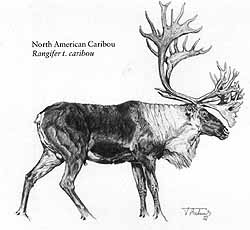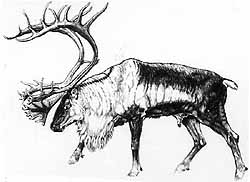English: Reindeer; French: Renne sauvage; Algonquin: adik, wsihak; Chinese: Yün-lu; Chipewyan: setthën; Cree: ateke; Danish: rensdyr; Dogrip: ?ekwo; Finnish: Poro; Greenlandic (Inuktitut): Tuttu; Icelandic: hreindyr: Loucheux: vadzaih; Mongol; Tsaa; Norwegian: Rein; Russian: Ssewernij Olen; South Slavey: medzih nodii; Swedish: Vildren.
 |
| Rangifer t. caribou |
Former distribution: All over the tundra and taiga regions of the Holarctic including all Artic islands, northern Mongolia and northern Heilongjiang in China.
Present distribution: Norway, Finland, Greenland, Spitzbergen, east through the tundra and taiga of the USSR to Sakhalin, northern Mongolia and northern Heilongjiang in China; the Bering Sea; USA in Michigan and northern Idaho, Alaska, Canada and adjacent islands; introduced into southern Georgia in the South Atlantic; 1952 reintroduced into Scotland and Finland.
Behaviour: Preferred habitat: tundra and taiga; highly gregarious forming herds of up to hundreds and thousands; activity diurnal. They migrate from summer to winter feeding grounds, led by a female. Their diet consists mainly of lichen, mosses, grasses, willow leaves and polar beech. Predators include wolves, wolverines, bears.
Population status: Stable. Total numbers: Several millions.
Brief notes:
Body weight: 200-300 kg
Head and body length: 120-220 cm
Tail length: 10-25 cm
Shoulder height: 110-130 cm
Gestation period: 210-240 days
Maximum age: 15 years
Trophy: Record SCI: Barrenground Caribou (Rangifer t. granti) 572 2/8 score, 1974 Alaska, WIN CONDICT; average 315 score. Mountain Caribou (Rangifer t. caribou) 315 score. 498 5/8 score, 1982 Yukon, STEVE WEBER; average 300 score. Woodland Caribou (Rangifer t. caribou) 376 7/8 score, 1984 Newfoundland, JOHN BLANTON; average 250 score. European Reindeer (Rangifer t. tarandus) 426 3/8 score, 1975 Sweden, RICARDO MEDEM; average 350 score. Peary Caribou (Rangifer t. pearyi) 331 7/8 score, 1983 N.W. Territories, ROBERT ZINGULA; average 230 score. European Reindeer (Rangifer t. tarandus) RW’s: 151.1 cm/25 points. 1908 Norway R.L. SCOTT; average 440 points. Spitzbergen Reindeer (Rangifer t. platyrhynchus) 130.8 cm/32 points. 1912 Spitzbergen, G.A. SHENLEY. B&C: Mountain Caribou (Rangifer t. caribou) 469 7/8 score, 1976 British Columbia, GARRY BEAU-BIEN; average 390 score. Woodland Caribou (Rangifer t. caribou) 419 5/8 score, 1910 Newfoundland, Nat. Collection; average 295 score. Barrenground Caribou (Rangifer t. granti, Rangifer t. groenlandicus): 463 6/8 score, 1967 Alaska, RAY LOESCHE; average 400 score. Quebec-Labrador Caribou (Rangifer t. caribou) 474 6/8 score, 1931 Labrador, ZACK ELBOW; average: 373. European Reindeer (Rangifer t. tarandus) CIC: 1000.5 points, Norway; average 700 points. Siberian Reindeer (Rangifer t. sibiricus) 998.00 points, USSR, P.F. BATICKY; average 700 points.
Hunting methods: Stalking, on horseback, from a hide.
Subspecies: 10 acc. to BANFIELD (1963) the following 3 groups can be distinguished:
1. Woodland caribou group
2. Tundra tarandus group
3. Arctic Island peary group The definition of the subspecies is still confusing, therefore the Author has listed 10 according to the classification of Caribou and Reindeer trophies (SCI, RW’s, CIC, B&C) as follows:
1. European Reindeer Rangifer t. tarandus Norway, Iceland, Finland and European USSR east to Urals. Stable. Norway: 30-40 000; Iceland: 5000; Finland: 700, and 70 in enclosures; USSR: 180 000; southern Georgia 4000 (introduced).
2. Spitzbergen Reindeer Rangifer t. platyrhynchus Spitzbergen and adjacent islands. Stable. Total 10 000.
3. Nowaja-Zemlja Reindeer Rangifer t. pearsoni Novaja Zemlya. Total population: 20-30. Endangered.
4. Siberian Reindeer Rangifer t. sibericus From Urals east to Siberia, Arctic islands to the Anadyr and the Chuckcen Peninsula. Stable. Estimated numbers: 800-900 000.
5. Siberian Woodland Reindeer Rangifer t. valentinae Southern Urals to the Altai and northern and north-eastern Mongolia. Stable. USSR: No records; Mongolia: Estimated number: 1000.
6. Manchurian Reindeer Rangifer t. phylarchus Amur, Chingan in China (Northern Nei Monggol and northern Heilongjiang), Sakhalin and Kamchatka. Stable. Estimated numbers: 15-25 000.
7. Greenland Reindeer Rangifer t. groenlandicus Northern and western Greenland. Rare. Estimated numbers: 510 000.
8. Peary’s Caribou Rangifer t. pearyi North-western territories in Canada. Stable. Estimated numbers: 25 000.
9. North American Caribou Rangifer t. caribou Canada from Alaska to Labrador and Newfoundland. Stable. Estimated numbers: 750 000.
10. Alaska Caribou Rangifer t. granti Alaska. Stable. Estimated numbers: 500 000.
Remarks: BANFIELD (1963) and WEMMER (1982) distinguish among these above listed
Subspecies 3 groups, caribou, tarandus and pearyi; but do not explain why R.t. platyrhynchus (Spitzbergen), and R.t. groenlandicus, and R.t. granti could be syn. to. More investigations on Caribou and Reindeer required to define taxonomic differences. All caribous and reindeer interbreed and intergrade so that any final reclassification is difficult. Semi-domesticated populations are widespread in the Holarctic tundra regions, as in Alaska on the Nunivak Islands, in USSR, northern Mongolia, in China; northern Nei Monggol (Inner Mongolia), and north-western Heilongjiang (Manchuria); Finland and Norway The total number of the reindeer population fluctuates due to the lichen resources of the different regions. The population of the Greenland reindeer was about 150 000 (1974-1975). Subsequently they decreased to a few thousand due to overgrazing of the lichen. Today the population is again about 15 000. Successful management of Reindeer requires an understanding of the availability of lichen, as well as the control of predators such as wolves, lynxes, wolverines, and – last but not least -controlled hunting. The Nearctic caribous are bigger in body and better in trophy quality than the Palaearctic specimens.
|








